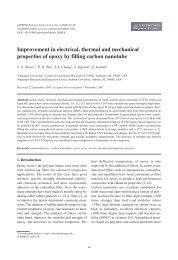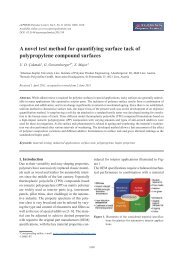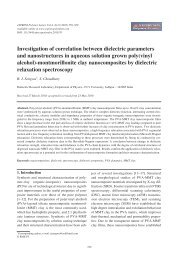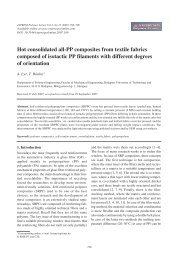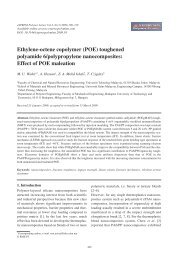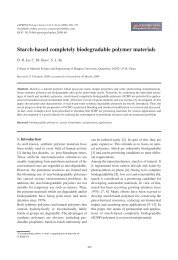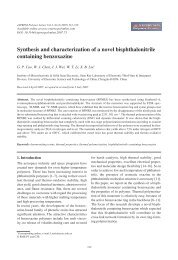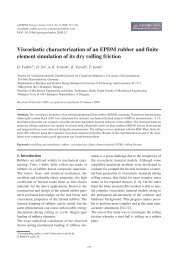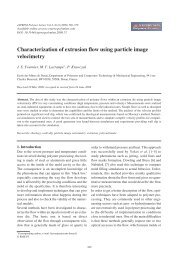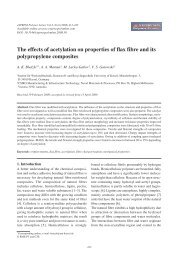Nanotechnology and its applications in lignocellulosic composites, a ...
Nanotechnology and its applications in lignocellulosic composites, a ...
Nanotechnology and its applications in lignocellulosic composites, a ...
Create successful ePaper yourself
Turn your PDF publications into a flip-book with our unique Google optimized e-Paper software.
Kamel – eXPRESS Polymer Letters Vol.1, No.9 (2007) 546–575<br />
that the whisker concentration, suspension of cellulose<br />
whiskers will be obta<strong>in</strong>ed [90].<br />
Figure 6. Schematic diagram to show polymer nanofibers<br />
by electrosp<strong>in</strong>n<strong>in</strong>g.<br />
Polymers, molten <strong>in</strong> high temperature, can also be<br />
made <strong>in</strong>to nanofibers through electrosp<strong>in</strong>n<strong>in</strong>g.<br />
Instead of a solution, the polymer melt is <strong>in</strong>troduced<br />
<strong>in</strong>to the capillary tube. However, different<br />
from the case of polymer solution, the electrosp<strong>in</strong>n<strong>in</strong>g<br />
process for a polymer melt has to be performed<br />
<strong>in</strong> a vacuum condition [86–88]. Namely,<br />
the capillary tube, the travel<strong>in</strong>g of the charged melt<br />
fluid jet <strong>and</strong> the metal collect<strong>in</strong>g screen must be<br />
encapsulated with<strong>in</strong> a vacuum. A schematic diagram<br />
to <strong>in</strong>terpret electrosp<strong>in</strong>n<strong>in</strong>g of polymer<br />
nanofibers is shown <strong>in</strong> Figure 6.<br />
A polymer solution, such as cellulose acetate dissolved<br />
<strong>in</strong> 2:1 acetone: dimethyl acetamide was<br />
<strong>in</strong>troduced <strong>in</strong>to the electric field. The polymer filaments<br />
were formed, from the solution, between two<br />
electrodes bear<strong>in</strong>g electrical charges of opposite<br />
polarity. One of the electrodes was placed <strong>in</strong>to the<br />
solution <strong>and</strong> the other onto a collector. Once<br />
ejected out of metal sp<strong>in</strong>nerets with a small hole,<br />
the charged solution jets evaporated to become<br />
fibers which were collected on the collector [89].<br />
2.1.3. From sea animals<br />
Colloidal suspensions of cellulose whiskers <strong>in</strong><br />
water were prepared as follow<strong>in</strong>g; the shells of the<br />
tunicates cut <strong>in</strong>to small fragments <strong>and</strong> bleach by<br />
three successive treatments with sodium hypochlorite<br />
<strong>in</strong> dilute acetic acid. Heat the mixture to<br />
70–80°C <strong>and</strong> keep at this temperature for 1 hour.<br />
After the third cycle, the tunicate mantles isolate<br />
via decant<strong>in</strong>g, wash with ice water, <strong>and</strong> dis<strong>in</strong>tegrate<br />
<strong>in</strong> blender <strong>in</strong>to an aqueous suspension (tunicate<br />
content ~3% w/w). The dis<strong>in</strong>tegrated mantles subsequently<br />
hydrolyze by add<strong>in</strong>g concentrated sulfuric<br />
acid, heat<strong>in</strong>g the mixture to 80°C, <strong>and</strong> rigorous<br />
stirr<strong>in</strong>g at this temperature for 20 m<strong>in</strong>ute to yield a<br />
suspension of cellulose whiskers. After wash<strong>in</strong>g<br />
with water until the pH is neutral, add<strong>in</strong>g water so<br />
2.1.4. From microcrystall<strong>in</strong>e cellulose <strong>in</strong> organic<br />
solvent<br />
The microcrystall<strong>in</strong>e cellulose was swelled <strong>and</strong><br />
partly separated to whiskers by chemical <strong>and</strong> ultra<br />
sonification treatments. Dimethyl acetamide with<br />
0.5 wt% LiCl solution was used as swell<strong>in</strong>g agent.<br />
The microcrystall<strong>in</strong>e cellulose <strong>in</strong> LiCl/dimethyl<br />
acetamide was 10 wt% which was agitated us<strong>in</strong>g a<br />
magnetic stirrer for 12 hour at 70°C to swell the<br />
microcrystall<strong>in</strong>e cellulose particles. The slightly<br />
swelled particles were then sonicated <strong>in</strong> an ultrasonic<br />
bath for 3 hours over a period of 5 days with<br />
long <strong>in</strong>tervals between each sonication treatment,<br />
to separate cellulose nano whiskers [91].<br />
2.1.5. By acid hydrolysis<br />
Suspensions of nanocrystall<strong>in</strong>e cellulose were prepared.<br />
Hydrolysis was carried out with sulfuric acid<br />
with constant stirr<strong>in</strong>g. Immediately follow<strong>in</strong>g the<br />
acid hydrolysis, the suspension dilute 10-fold with<br />
deionized water to quench the reaction. The suspension<br />
centrifuges at 6000 rpm for 10 m<strong>in</strong> to concentrate<br />
the cellulose <strong>and</strong> to remove excess<br />
aqueous acid. The resultant precipitate should be<br />
r<strong>in</strong>sed, recentrifuged, <strong>and</strong> dialyzed aga<strong>in</strong>st water<br />
for 5 days until constant neutral pH [92].<br />
2.1.6. From bacterial cellulose<br />
Cellulose can be synthesized by some bacteria [31,<br />
33]. For example, the cellulose was produced by<br />
static cultivation of Acetobacter xyl<strong>in</strong>um, sub<br />
species BPR2001, <strong>in</strong> a fructose/CSL medium at<br />
30°C [93]. The bacteria were grown <strong>in</strong> 400 ml<br />
Erlenmeyer flasks conta<strong>in</strong><strong>in</strong>g 100 ml of media. In<br />
order to remove the bacteria <strong>and</strong> to exchange<br />
rema<strong>in</strong><strong>in</strong>g media, the produced cellulose pellicles<br />
were boiled <strong>in</strong> 1 M NaOH at 80°C for 1 hour followed<br />
by repetitive boil<strong>in</strong>g <strong>in</strong> deionised water. To<br />
prevent dry<strong>in</strong>g <strong>and</strong> to avoid contam<strong>in</strong>ation, the<br />
washed cellulose was stored <strong>in</strong> diluted ethanol <strong>in</strong> a<br />
refrigerator.<br />
The advantage <strong>in</strong> us<strong>in</strong>g bacterial cellulose as a<br />
model for plant cellulose lies <strong>in</strong> <strong>its</strong> high purity, f<strong>in</strong>e<br />
fibrils (high surface area) [94], high tensile strength<br />
<strong>and</strong> water-hold<strong>in</strong>g capacity. So, bacterial cellulose<br />
555




